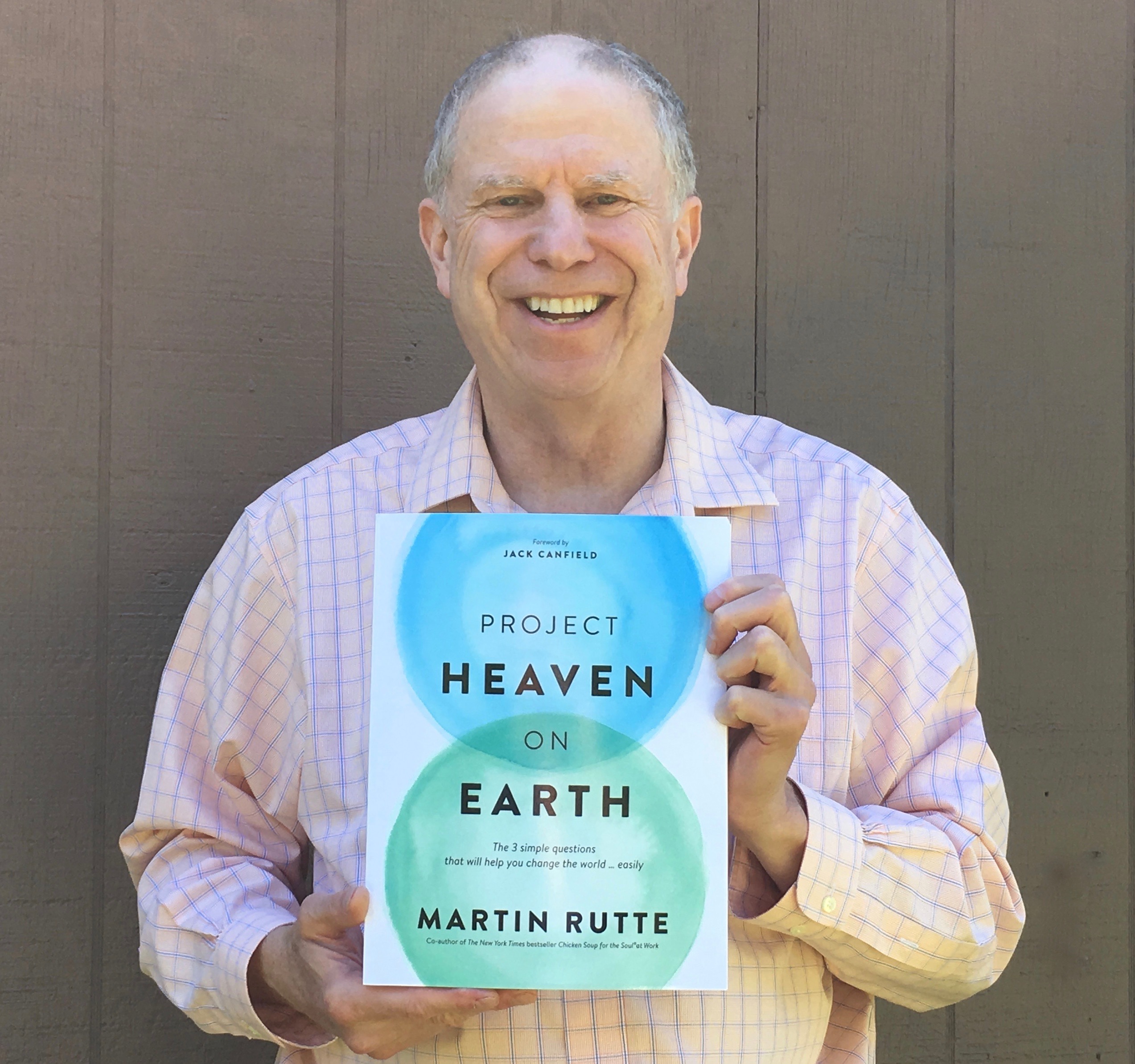To share this post by email, click here.
An Unexpected Path to Heaven on Earth
by Tim Kelley, global change agent and author of True Purpose
For most people, creating a specific vision of Heaven on Earth can be challenging. Our brains have an inherent negativity bias which tends to focus on what we fear rather than on what we want. While this may have been a useful evolutionary adaptation, it makes it exceedingly difficult to focus on a truly positive vision of the future, fully free of the limiting beliefs constraining our imaginations.
Martin Rutte has made a career out of helping people overcome this obstacle. He’s demonstrated that most individuals are able to conceive of some feature of Heaven on Earth by starting with a specific area of focus area and going through a few simple steps to begin making it real in the world.
For Heaven on Earth to become a reality, our individual visions will need to be aggregated into a shared vision. Getting collective agreement on a shared vision is the hard part; once we have that, implementing it will be relatively straightforward.
There’s another path to this goal that leverages our innate negativity bias. Most people are more problem- than vision-focussed, quicker to be aware of what they don’t like than what they do like. Most change agents are engaged in resisting and protesting what they don’t like about the current paradigm, rather than implementing a specific vision of a new one.
The process starts with a problem, something really intractable and divisive, like immigration, climate change, or wealth disparity. It’s important that people have some intensity around the topic, because that intensity provides the energy to see the process through.
The typical approach is to take a position on the problem, gather support for your point of view, and make those who disagree with you wrong. This has the unintended consequence of reinforcing and entrenching the current situation: the negative judgments each side has about the other keeps them in their corners, and the whole system becomes fixed in place and nearly impossible to budge.
Let’s look at this from another perspective. The seemingly intractable problem can actually form the foundation for constructing an aspect of Heaven on Earth. The intractable problem exists as a feature of the current paradigm. Change the paradigm and the problem goes away. As Buckminster Fuller put it, “You never change things by fighting the existing reality. To change something, build a new model that makes the existing model obsolete.”
In effect, the “problem” becomes both the lever for implementing a feature of Heaven on Earth and the blueprint for how to do it.
Instead of trying to get rid of the thing you don’t like, you have to look at it as a building block for Heaven on Earth. This can be challenging at first, since the natural impulse is to try to rid the world of war, poverty, pollution, racism, etc. In order to view the problem as a building block, answer these two questions:
1. How can this feature of the current paradigm be used as a tool for creating Heaven on Earth?
Remember, “getting rid of it” isn’t a strategy for using the feature to create Heaven on Earth. Another way of asking this question is, “How is it easier to create Heaven on Earth because this feature of the current paradigm exists?” Answering this question well opens an entirely new arena of possibility.
2. What might Heaven on Earth look like if this feature were still present?
This is the really challenging question, and the most important one. Rather than delaying the implementation of Heaven on Earth until you can get rid of this thing (and all the other things you don’t like about the current paradigm), it will happen much more quickly if you can imagine a version of Heaven on Earth that still contains this feature. Doing this forces you to let go of your judgment of this thing as “bad.”
Let’s work with a popular example: wealth disparity. America’s “Occupy Wall Street” movement is an excellent case study in why the typical resistance-based methods rarely work. In essence, what they’re saying is “Wealth disparity is bad, and wealth disparity is the fault of rich people and corporations. Let’s all agree that they’re bad and resist them.” This is where the change process ends: rich people and corporations aren’t going to change their behavior based solely on being declared “bad” by a subset of the population. What specific action is there for them to take? Blame doesn’t create a new system or offer a workable plan to create one.
Let’s use our two questions above instead.
Question #1: “How can wealth disparity be used as a tool for creating Heaven on Earth?”
Change agent Inbal Cohen Amitai, one of the few Certified True Purpose® Coaches in Israel, gave me a great answer to this question. She was reflecting on the tent city movement there, a precursor to Occupy Wall Street. It was a series of camp-in demonstrations against the fact that roughly six families in Israel own an enormous proportion of the total wealth.
“If the wealth in the world is highly concentrated, it is easier to deploy. As we create and manifest Heaven on Earth, at times we will need to focus enormous resources to deal with specific issues. Those who have great wealth can do so quickly and efficiently.”
“Why would they do that,” you might ask? This raises an issue that gets in the way of solving big problems: limiting beliefs. If you believe, for example, “rich people are selfish,” Inbal’s approach might seem ludicrous to you. But there’s a word for a statement like, “All people who are x are also y.” It’s called “prejudice,” the act of “pre-judging” someone you don’t know based on limited information about them. The term is traditionally used in the context of racism and sexism, but it applies equally well to sweeping judgments made about any group (in this case, wealthy people and corporations).
In fact, wealthy people and corporations donate enormous amounts of money to charity already. A growing list of billionaires has pledged to donate half of their total wealth to creating a better world. And think how much easier it would be to convince wealthy people and corporations to use their resources and power to take on big issues if they were being celebrated and thanked, rather than being blamed for the world’s ills!
Question #2: “What might Heaven on Earth look like if it included wealth disparity?”
We’re not trying to create a compromised Heaven on Earth. We want the full brilliance the term implies, which means that wealth disparity somehow needs to be a good thing. What is the opposite of wealth disparity? In a purely mathematical sense, wealth equality, everyone owning or having access to exactly the same resources. People are unique, and so are their needs and desires. Trying to ensure that everyone has exactly the same amount would be a Herculean task and would upset a very large number of people – not Heaven on Earth! The problem isn’t that people have different amounts; it’s that some people have less than they need to be happy. So, we don’t need to eradicate inequality; we need to make sure that everyone has enough of what they need and desire to live happy, healthy, fulfilling lives. Now we’re no longer on a vendetta against the wealthy. We’re trying to create what Lynne Twist calls “sufficiency” – having what you need, when you need it, in the amount you need it.
Is it easy to create this state of sufficiency for all humans? No, it is not. But it is a project that you could convince the wealthy and powerful to participate in, which isn’t likely if you start by blaming them for the current situation and planning to confiscate their wealth as a first step in the change process. In other words, it is an achievable goal that will invite way fewer objections than a class warfare frame does. And it will enroll many people on both sides of the wealth divide.
Granted, this is a pretty superficial treatment of a complex topic. This is an example in a blog post, not a book. If it is your purpose to wrestle with wealth disparity or any other issue creating suffering in our world, keep going! Flesh it out! Create a detailed vision of Heaven on Earth that includes wealth disparity (or your issue), and a detailed plan for getting from here to there!
Your homework: Take an issue that pains you, that gets under your skin, something that you are convinced is bad and must be destroyed before you can create Heaven on Earth. Then ask the two questions. Share your answers with others, and ask them for their answers, too. If you give this process the time it deserves, it should lead you to an alternative, more easily achieved vision of Heaven on Earth, and a shorter path to get there.
If you’d like to learn more about Tim, you can go to this site:


 Martin Rutte
Martin Rutte




